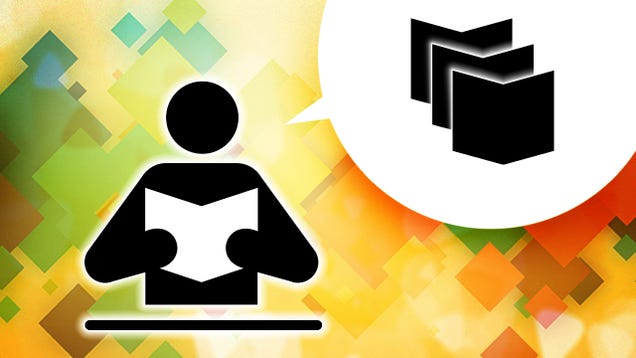How to Self-Publish a Book
 EXPAND
EXPAND
 EXPAND
EXPAND
Twenty years ago, if you were a new author interested in getting your book published, you had to shop it around with publishers and hope that someone, eventually, might not reject you. But nowadays you can choose to self-publish anything you'd like. Here's how.
In the old dynamic of getting your book in print, authors basically had three options:
- Send a manuscript to publishers. If you were lucky, an editor at one of the big publishing houses would have plucked it from the so-called "slush pile" of unsolicited manuscripts. Your publishing contract may have included an "advance," a sum of money that will be paid back with royalties earned from the sale of your book. The royalty rate? About 8-10% for mass market paperbacks.
- Commission an agent to shop around your manuscript. A good agent would be able to get your book in front of the right people at the right publishing houses (for a price).
- Have a vanity press handle publishing. You would send in your manuscript, and pay a large fee to get several hundred copies published. It would be up to you to sell them… or give them away.
That was then, this is now. The rise of tablets and the launch of self-publishing platforms have made it possible for anyone to release their own book to the world, without going through the traditional gatekeepers or costly vanity presses.
However, it's still easy to get burned with self publishing. I learned some of the pitfalls, ripoffs and mistakes the hard way, when I began publishing the In 30 Minutes series of how-to guides in 2012. Since then, I have started a small publishing company and have heard from lots of newbie authors who are unsure about how to get started.
Whether you have a fiction masterpiece, a biography, nonfiction work or children's book, these pointers will help you navigate the brave new world of self-publishing.
Get Words on the Page
First of all, you don't need to have a certificate in creative writing, an Ivy League degree, or any other "qualification" to self-publish. All you need is a passion for writing, the ability to produce something that other people want to read, and your preferred writing tool. Once your manuscript is ready, use a self-publishing service to put your book in front of readers. Learn from their feedback to make an even better follow-up title.
Do you have an editor? While not required for self-publishing, editors can help make your story flow better, strengthen plots and characters, spot inconsistencies, and generally make your book more interesting and approachable in both fiction and nonfiction. Even if you don't have a professional editor to work with, a second opinion always helps. And you may want to ask someone who you know won't just give you polite praise.
Also have someone proofread your book before you submit it. A proofreader can spot spelling and grammatical errors as well as style issues. Experienced proofreaders can be hired throughoDesk at reasonable hourly rates (expect to pay for one hour of their time for every 5,000 words of text), but you can also ask a friend (a good, patient friend!) to do it. Be sure you have a system in place for tracking and inputting changes (for instance, Word's Track Changes feature, or standard copy editor markup).
Find the Right Distributor for You
Don't use any book publishing service which demands an up-front fee and/or an excessive cut of sales revenue—there's simply no reason to pay for expensive vanity publishers anymore.
The biggest ebook self-publishing platform is Amazon's Kindle Direct Publishing (KDP) program. If you upload your manuscript to KDP, it will appear for sale on Amazon.com, where readers can download it to their Kindles. KDP is free to use, and KDP authors keep up to 70% of revenue from the sales of their books. Similar self-publishing services are offered by Barnes & Noble (through Nook Press), Apple (through iTunes Connect) and others, but Amazon's is one of the most widely available platforms and is easy to use.
If you want to see your book in print, CreateSpace (owned by Amazon) has a great print-on-demand service. CreateSpace takes your content files (cover and interior) and only prints books that are ordered through Amazon and other channels. You never have to worry about inventory or ordering large print runs to stock the warehouse. CreateSpace charges a printing fee for each book, plus the cut taken by each channel (for instance, 40% for Amazon) and you keep the rest. But if want the tactile sensation of holding your book in your hands, CreateSpace's print-on-demand service is hard to beat.
Format Your Text and Submit It to Your Platform of Choice
The bare minimum to self-publish your book on Kindle and other ebook platforms is amanuscript in Microsoft Word. However, print-on-demand services general request a PDF formatted according to their specifications.
You also need to provide some simple information (called metadata) about your book. Metadata includes the title and subtitle, author name and bio, the description of the book, categories, and keywords. Get this right—this data will influence how your book appears in search results on Amazon and other marketplaces. A well-written and honest description will help convert more browsers to buyers (and hopefully, loyal readers)!
If the formatting requirements, self-publishing portals, or other technological aspects associated with self-publishing seem too daunting, you can use services such as Smashwords to streamline the process. Smashwords takes your Word manuscript and metadata, converts it to an ebook, and distributes it to multiple self-publishing platforms for a small cut of sales. Many new authors find that Smashwords saves them a lot of time and aggravation.
Get the Book in Front of Readers
If you want to sell more books, get a good cover from an experienced designer! Professionally designed covers make your book look professional, and help them stand out in crowded online book marketplaces. In my own experiments, having a professional ebook cover design increased sales by about 50%.
Marketing is critical to getting noticed, but concentrate on those activities which generate the best results, whether it be sales, engagement with customers, or joking around on Twitter. Experiment, learn from your readers, and talk with other authors regarding what works best, but don't waste time on activities which generate minimal results.
Reviews from readers, bloggers, and professional reviewers can be crucial. While it may be tempting to ask all of your friends to spread five-star reviews, the best reviews are honest reactions by real readers. If you've corresponded with someone who enjoyed your book, ask if they wouldn't mind writing a review.
What is an ISBN and Do I Need One?
You don't need to buy ISBNs. ISBNs (International Standard Book Number) records contain author, publisher, size, format, topic-related information, pricing, and other data needed by retailers, libraries, and book distribution systems. If you want to publish a print edition of your book, you'll eventually have to get an ISBN assigned to the title, but it costs money. The American ISBN provider is Bowker.
Fortunately, you don't have to get an ISBN for ebooks published through Amazon KDP, Apple iTunes, Nook Press, or Google Play. If you want to use CreateSpace for publishing a print book, CreateSpace will supply an ISBN for free.
Pursue Other Opportunities for Promotion
In my opinion, you don't need an agent if you do a lot of promotion yourself. If your book shows promise as a self-published title, agents will probably reach out to you. However, before you sign a deal with anyone, remember that even if an agent can secure a professional publishing deal, they'll take a cut and the royalty granted to authors by traditional publishers is far less than you would get through self-publishing.
If you have a blog, then you're already a writer with a platform. Obviously, you should promote your books to your audience. Some bloggers have even taken to posting sample chapters to their blogs before they publish, in order to get feedback from readers.
Another avenue for community support and feedback are online writing communities. My favorite is Kboards Writer's Corner, which is a great place to discuss self-publishing and ask for advice from other writers.
Be realistic. Your book won't be the next 50 Shades of Grey. The hype over breakout self-publishing successes has convinced thousands of new authors that they too will strike it rich with their first manuscript. It's not going to happen. The marketplace for books has become much more crowded, and it usually takes years of hard work (and several compelling titles) to stand out.
Don't let this last point about self-publishing bring you down. If you're passionate about writing, self-publishing is an opportunity to practice your craft and publish your work. For many new authors, it's a rewarding feeling to connect with readers and earn a little money.Success may come down the road, but don't give up your day job yet.
Ian Lamont is the founder of i30 Media and the author of Dropbox In 30 Minutes and Google Drive & Docs In 30 Minutes. Follow him on Twitter at @ilamont.
Image adapted from Nemo (Pixabay) and PSDgraphics.
Want to see your work on Lifehacker? Email Andy.

























No comments:
Post a Comment